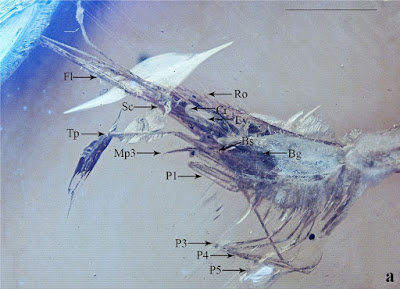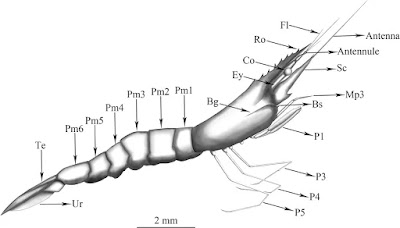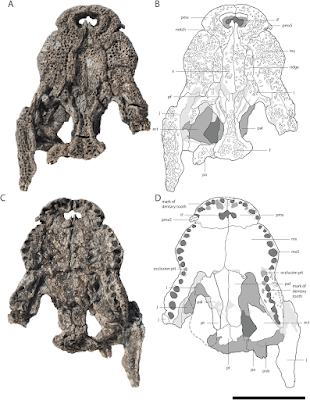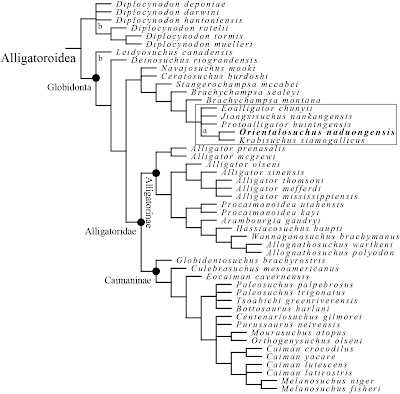[Most Recent Entries] [Calendar View]
Tuesday, November 5th, 2019
| Time | Event | ||||
| 3:49a | [Herpetology • 2019] Polypedates bengalensis • A New Species of Polypedates Tschudi, 1838 (Anura: Rhacophoridae) from West Bengal State, Eastern India
Abstract A new species of frog belonging to the genus Polypedates Tschudi is described from the state of West Bengal, Eastern India. A mid-sized frog, SVL ranges from 47.9–53.6 mm in males and 72.0 mm in the single female. The species is diagnosable in showing the following suite of characters: digits lack webbing, inner and outer metacarpal tubercles present; no dermal fold on forearm; toes webbed, webbing formula I1–1 II0.5–2III1–2IV2–0.5V; an inner metatarsal tubercle present; tibio-tarsal articulation reaches between eye and nostril; and skin on forehead co-ossified to cranium. Additionally, males possess paired vocal sacs. The new species is compared with known species of the genus Polypedates. Keywords: Amphibia, West Bengal, India, Polypedates, new species, 16s rRNA Jayaditya Purkayastha, Madhurima Das, Kingshuk Mondal, Shibajee Mitra, Anirban Chaudhuri and Indraneil Das. 2019. A New Species of Polypedates Tschudi, 1838 (Amphibia: Anura: Rhacophoridae) from West Bengal State, Eastern India. Zootaxa. 4691(5); 525–540. DOI: 10.11646/zootaxa.4691.5.6 Researchers discover new frog species in West Bengal | India News, The Indian Express indianexpress.com/article/india/research | ||||
| 10:15a | [Paleontology • 2019] Palaemon aestuarius • The First Amber Caridean Shrimp from Mexico Reveals the Ancient Adaptation of the Palaemon to the Mangrove Estuary Environment
Abstract The aquatic and semiaquatic invertebrates in fossiliferous amber have been reported, including taxa in a wide range of the subphylum Crustacea of Arthropoda. However, no caridean shrimp has been discovered so far in the world. The shrimp Palaemon aestuarius sp. nov. (Palaemonidae) preserved in amber from Chiapas, Mexico during Early Miocene (ca. 22.8 Ma) represents the first and the oldest amber caridean species. This finding suggests that the genus Palaemon has occupied Mexico at least since Early Miocene. In addition, the coexistence of the shrimp, a beetle larva, and a piece of residual leaf in the same amber supports the previous explanations for the Mexican amber depositional environment, in the tide-influenced mangrove estuary region. Systematic palaeontology Order Decapoda Latreille, 1802 Suborder Dendrobranchiata Bate, 1888 Infrorder Caridea Dana, 1852 Superfamily Palaemonoidea Rafinesque, 1815 Family Palaemonidae Rafinesque, 1815 Subfamily Palaemoninae Rafinesque, 1815 Genus Palaemon Weber, 1795 Palaemon aestuarius sp. nov. Holotype: STJ172. All length measurements are recorded in mm. Total length: 10.3, carapace length: 2.6, rostrum length: 2.2, abdomen length: 4.77, telson length: 1.28 (Figs 1a, b, 2 and S1). The materal deposited in the the Paleo-diary Museum of Natural History, Beijing, China. Type locality/horizon: Campo La Granja mine, Simojovel de Allende town, Chiapas, southeastern Mexico (Early Miocene, c. 22.8 Ma)16,19. Diagnosis: Rostrum without elevated basal crest, faintly convex in the middle, dorsal margin with nine teeth including one postorbital tooth, basal four teeth evenly distributed, the distance between them greater than the intervals of other teeth. Carapace smooth, branchiostegal groove extended longitudinally backward; branchiostegal spine sharp, situated on anterior margin of cephalon; hepatic spine absent. Length of non-chelate pereiopods increasing gradually from third to fifth; ischium slightly longer than the length of propodus, about 2–3 times as long as carpus, merus longest, dactylus the shortest, apices inwardly hooklike. Etymology: The specific name comes from the Latinization “estuary” where the shrimp inhabited. Remarks: P. aestuarius sp. nov. resembles Palaemon vesolensis Bravi, Coppa, Garassino & Patricelli, 1999, the difference between them in: P. aestuarius sp. nov. with nine teeth on the dorsal margin, carapace bearing prominent branchiostegal groove; but the P. vesolensis with seven dorsal teeth, carapace without traces of grooves.
Bao-Jie Du, Rui Chen, Xin-Zheng Li, Wen-Tao Tao, Wen-Jun Bu, Jin-Hua Xiao and Da-Wei Huang. 2019. The First Amber Caridean Shrimp from Mexico Reveals the Ancient Adaptation of the Palaemon to the Mangrove Estuary Environment. Scientific Reports. 9; 14782. nature.com/articles/s41598-019-51218-5 | ||||
| 2:55p | [Paleontology • 2019] Orientalosuchus naduongensis • A New Alligatoroid from the Eocene of Vietnam highlights An Extinct Asian Clade Independent from Extant Alligator sinensis
Abstract During systematic paleontological surveys in the Na Duong Basin in North Vietnam between 2009 and 2012, well-preserved fossilized cranial and postcranial remains belonging to at least 29 individuals of a middle to late Eocene (late Bartonian to Priabonian age (39–35 Ma)) alligatoroid were collected. Comparative anatomical study of the material warrants the diagnosis of a new taxon, Orientalosuchus naduongensis gen. et sp. nov. The combined presence of an enlarged fifth maxillary tooth, prominent preorbital ridges, a large supraoccipital exposure on the skull table, a palatine-pterygoid suture anterior to the posterior end of the suborbital fenestra, and a pterygoid forming a neck surrounding the choana is unique to this species. Unlike previous phylogenies, our parsimony analysis recovers a monophyletic Late Cretaceous to Paleogene East to Southeastern Asian alligatoroid group, here named Orientalosuchina. The group includes Orientalosuchus naduongensis, Krabisuchus siamogallicus, Eoalligator chunyii, Jiangxisuchus nankangensis and Protoalligator huiningensis, all of them sharing a medial shifted quadrate foramen aerum. The recognition of this clade indicates at least two separate dispersal events from North America to Asia: one during the Late Cretaceous by Orientalosuchina and one by the ancestor of Alligator sinensis during the Paleogene or Neogene, the timing of which is poorly constrained. Orientalosuchus naduongensis gen. et sp. nov. Orientalosuchus Etymology: The name Orientalosuchus refers to the Latin word “oriens” for “east” and “suchus” the old Greek word “soukhos” for “crocodile.” Orientalosuchus naduongensis Etymology: The species name “naduongensis” refers to the Na Duong coal mine type locality in northeastern Vietnam. Diagnosis: Orientalosuchus naduongensis is diagnosed by the combination of the following characters: notch between the premaxilla and maxilla; dominant maxillary ridge alongside the nasal; the fifth maxillary tooth is the largest maxillary tooth; anterior tip of frontal is acute and projects between the nasal bones; small supratemporal fenestra; large supraoccipital exposure preventing the parietal from reaching the posterior skull table in adults; quadrate foramen aerum lies on the dorsomedial angle of the quadrate; large suborbital fenestrae reaching anteriorly the level of the seventh to eighth maxillary tooth; maxilla-palatine suture forms an obtuse angle and not reaching beyond the anterior end of the suborbital fenestra; palatine-pterygoid suture lies anterior to the posterior end of the suborbital fenestra; pterygoid forms a neck surrounding the choana; dentary tooth row with only 16 teeth; laterally compressed posterior teeth; very small external mandibular fenestra; foramen aerum at the lingual margin of the retroarticular process; axis with a hypapophysis that is located near the center of the centrum; coracoid with a very large glenoid; iliac blade with a rectangular posterior outline and a dorsal indentation; dorsal osteoderms with no or only modest ridge. ... Conclusions: Parsimony analysis finds the new late Eocene taxon from Vietnam, Orientalosuchus naduongensis, as the sister taxon to Krabisuchus siamogallicus from the Eocene of Thailand. Together they form a monophyletic extinct basal East to Southeastern Asian alligatoroid clade of Late Cretaceous origin that also included Jiangxisuchus nankangensis, Eoalligator chunyii and Protoalligator huiningensis. The current phylogeny supports at least two different dispersals from North America to Eastern Asia: one during the Late Cretaceous (Orientalosuchina) and a second during the Cenozoic (Alligator sinensis lineage). Improved fossil calibrations and taxon sampling will be vital for further constraining the timing and resolving the climatic/paleogeographical context of these dispersals. Tobias Massonne, Davit Vasilyan, Márton Rabi and Madelaine Böhme. 2019. A New Alligatoroid from the Eocene of Vietnam highlights An Extinct Asian Clade Independent from Extant Alligator sinensis. PeerJ. 7:e7562. DOI: 10.7717/peerj.7562 |
| << Previous Day |
2019/11/05 [Calendar] |
Next Day >> |










